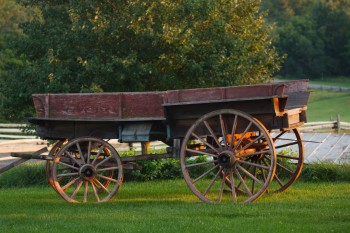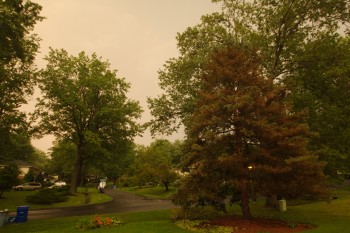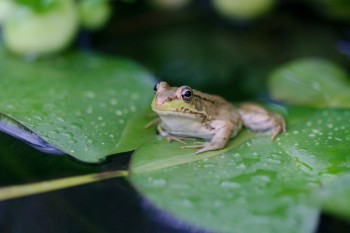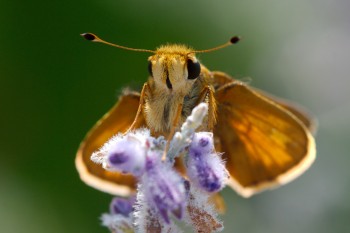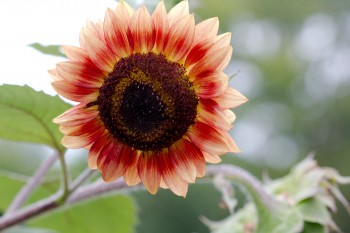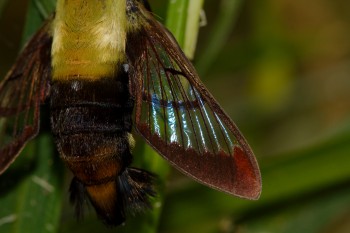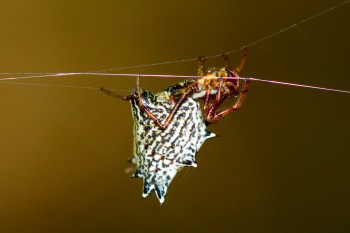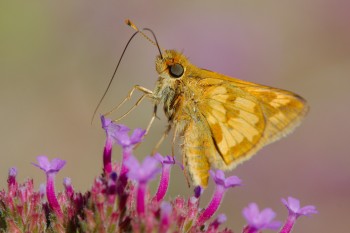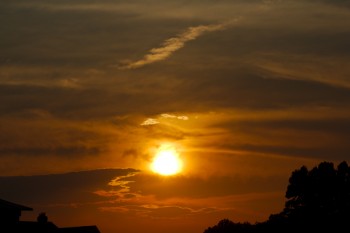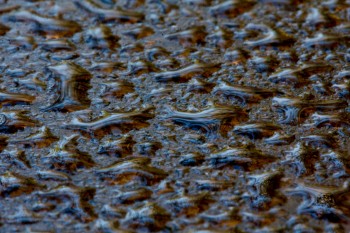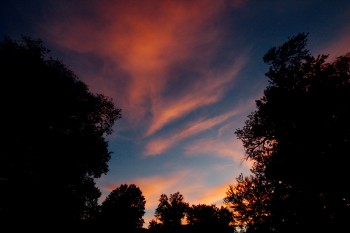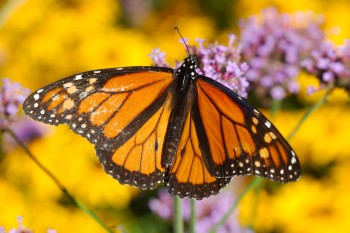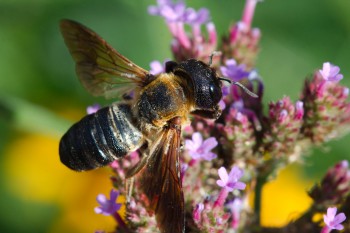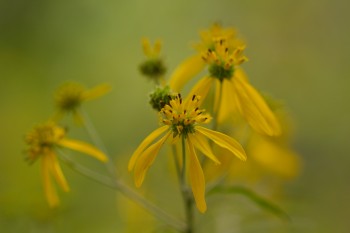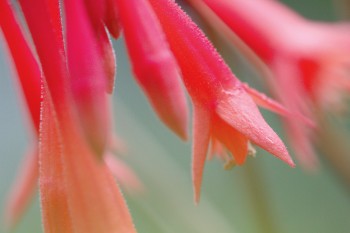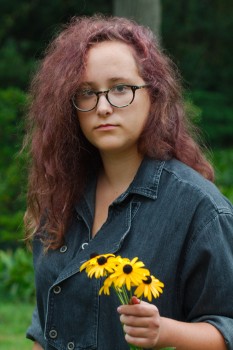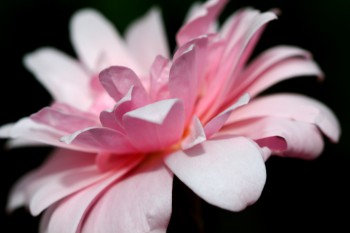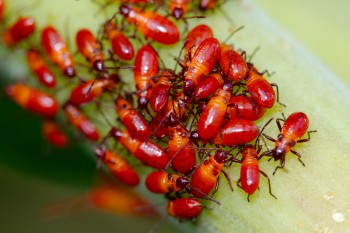I went out to take pictures this evening and didn’t find a lot new to photograph. There were some old mushrooms and I got pictures of them, but they were pretty ugly pictures of mushrooms turning to mush. There are still a huge number of black-eyed Susans and blue mistflower (Conoclinium coelestinum), a fairly prolific herbaceous perennial with frilly, pale blue flowers. I wanted something different so here’s a photo of a black-eyed Susan from behind, with a bit of mistflower in the foreground. Actually, we have some mistflower with white flowers. I don’t know if that’s a common, natural variation or not, but they are nice. I should photograph them at some point.
Black-eyed Susan, From Behind
Farm Wagon
Like the picture I posted from yesterday evening (which was incorrectly dated as September 3), I took a few evening pictures today as the sun was sinking into the west. This time, I happened to be near the Agricultural Farm Park on Muncaster Road so I pulled in to see what I could find to photograph. This is an old wagon sitting near the barn and the late-day sun was shining on it very prettily. After about five minutes of taking pictures, though, the sun was behind the trees and the light was gone. Pretty while it lasted, though.
Dusk
I took a few pictures this evening although I can’t say that they are very interesting. It rained again this evening and as the sun was getting low in the sky, the whole area took on a beautiful, slightly yellow glow. This photograph doesn’t really do it justice and of course it’s just a photo of our neighborhood, so not a lot to look at, but perhaps it will give you some idea. If you’ve ever seen this, then you know what I’m talking about and maybe you’ll appreciate it. Anyway, this is all I have today.
Drink Coca-Cola In Bottles
Big day today. We drove Dorothy to her new home for the next nine months or so, dropping her off in Richmond. All went well and we had no trouble with traffic except the last few miles, because it was morning rush hour by the time we arrived. Dorothy got settled into her new room, we met a few of her apartment mates, and we ran a few errands. Many of the old brick buildings have ghosts of painted signs on them but I noticed this one that’s not quite dead yet.
Green Frog (Lithobates clamitans)
It was another sweltering day today. Summer seems to have arrived at last and at one point the thermometer out back read 98°F. In the afternoon we took a short outing to the Agricultural Farm Park to enjoy their garden. This little fellow, which I believe is a green frog (Lithobates clamitans) was in a little pond in the garden. While we were there, it started to rain lightly and shortly came down quite hard for a while. The temperature dropped more than 20°F, though, so the rain was more than welcome.
Skipper on Russian Sage
Dorothy and I went in to church early this morning because she was singing and needed to be there for practice. I forgot to bring my book, so I had some free time. There are two small islands in the parking lot planted with caryopteris, which is quite happy there and blooming quite profusely. That’s another good insect magnet and I decided to go see what I could find. I like the head-on pictures I took of a small skipper on the top of a caryopteris stem. It’s a little thing, only about 1.5cm across.
Update: I originally labeled the flower this skipper is on as Caryopteris. It’s not. Instead, it is Russian Sage (Perovskia atriplicifolia). I often get those mixed up in my head, but fortunately, Cathy keeps them straight.
Sunflower
Here’s a second photo from our brief visit to Rocklands Farm in Poolesville. Many of the sunflowers have passed their peak and were starting to dry up but a few were still in fine form. Dorothy and I particularly liked this one, with the red added to the petals. Photographing sunflowers can sometimes be tricky because the are so tall. You often end up with very bright sky behind them. In this case, I moved around until there were at least a few trees behind the flower to put a little something in the background.
Hemaris diffinis (Snowberry Clearwing)
Dorothy and I went out the Rocklands Farm this afternoon. We were mostly there to pick up a few things from Janis, but as usual, I took the opportunity to take a few pictures. The first of them is this sphinx moth, a Snowberry Clearwing (Hemaris diffinis). I’ve seen them many times, usually hovering around flowers and posted a picture of one back on July 07, 2013. This one was down in the grass on the edge of a field and I’m not sure how I even spotted it. I’m glad I did though, because I was able to get quite close. I took some of the entire moth but I like this close-up, that shows the details of the wing.
Micrathena gracilis (Spined Micrathena)
I had to go the the next building over this afternoon so I took my camera with me. Then, on the way back to my office I walked through the woods for a little while. I nearly walked into a spider web, which I don’t particularly enjoy, but stopped in time. Then I got some pictures of the little lady minding the web. Actually, I took about one and a half dozen pictures, but all of them are blurry or out of focus except two. First, it was fairly dark in the woods. Then, the web was moving back and forth a little in the breeze. Finally, I was standing on a fairly steep hillside, trying to avoid falling into the spider’s web. When I went around so that the sun was behind me and when the spider moved into a very small shaft of sunlight, I was able to get this picture, which I’m pretty pleased with.
Polites peckius (Peck’s Skipper)
The sun was hot today and the insect activity out back was intense. On the mountain mint (Pycnanthemum muticum) there were bees and wasps of all descriptions. Out in the middle of the yard, on the patch of purple vervain (Verbena bonariensis) there were dozens, if not hundreds of skippers and a handful of cabbage whites (Pieris rapae). This is a Peck’s skipper (Polites peckius) that let me get close enough for a pretty good portrait.
Sunset
Dorothy drove us to church this evening, freeing me up to take some pictures while we were on our way. The sun was low in the sky, so I put the long lens on and took a few pictures when I had a break in the trees. It’s not the sort of sunset picture that’s going to win any awards. In general, I recommend finding a good location, stopping the car, and setting up a picture like this, but sometimes you have to take what you can get. Considering how it was taken, though, I think it’s reasonably pretty
Dew Droplets on Glass Table
It’s been hot the last few days and the forecast is for even hotter today, but it was cool this morning and there was a very heavy dew on the ground. We have a glass table on our patio that was covered with large water droplets and I took some pictures of it this morning before heading to work.
I actually took the opportunity to take some pictures at different apertures that illustrate depth of field. This one was taken at f/32 and, as you can see, it’s pretty much all in focus except the extreme foreground and back edge.
Sunset
It was another gorgeous day today, again a bit warming, up near 90°F, but a fabulous, blue sky with a few scattered clouds. As the sun dropped into the west the sky darkened to an even prettier, deeper blue. Then the clouds began to light up with a wonderful orange color.
This was the view out our kitchen door at two minutes to eight. Not bad, eh?
Monarch and Resin Bee
It was another beautiful day, a bit warmer than it’s been, but then it is August. I worked in the yard quite a bit this afternoon, doing a lot of weeding. It was mostly thistles and fleabane, ignoring the smaller weeds. I also cut a fair amount of dead wood out of a few of the roses. The pink multiflora rose was an absolute thicket of canes and my arms are a bit worse for the work, but the rose will be happier for it. When I had filled two barrels with yard waste (packed down quite a bit), I took a break and sat in the shade with a good book and a cold drink. I didn’t get very far in my reading, though.
I noticed a monarch butterfly (Danaus plexippus) on the Verbena bonariensis growing in the middle of our back yard. I was able to get pretty close and picked this one as the best, partly because of the bright background of black-eyed Susans. While I was taking pictures of him (it’s a male) I noticed a fairly large bee. It’s about an inch long and is a Sculptured Resin Bee (Megachile sculpturalis). They were recently introduced to eastern north America from their native Japan and eastern China, having first been seen in North Carolina in 1994.
Dripping Water
It rained quite a bit this afternoon. I had planned to doing a bit of yard work but didn’t feel like getting soaked. Cathy actually did a fair amount. I preferred to sit on the back patio, under cover of the roof, and read. I took a few breaks to take some pictures, including this one. There is a pile of patio chairs and water was dripping through them, making very nice rings. I like this one, partly because of the extra little rings around the main one.
Verbesina alternifolia (Wingstem or Yellow Ironweed)
In the past, particularly in my first year of taking a picture every day (2011), I often went out into the “empty” lot next to my building. I put empty in quotes because it is only empty in the sense that there is no building on it. It’s full of other things, like trees, herbaceous and woody perennials, and annuals. There is a stream that cuts across it, as well. Anyway, I went out this afternoon and looked around for something to photograph. This time of year isn’t all that interesting, photographically. The plants are mostly starting to turn brown, flowers are mostly finished but seeds have not yet developed. This plant is an exception. It is, I believe, commonly known as wingstem or yellow ironweed (Verbesina alternifolia). If not, it is a closely related species. Anyway, it’s quite pretty, especially at this otherwise drab time in the woods. The two difficulties photographing this are that it’s relatively dark where they are growing, under a canopy of trees, and they are mostly about eight feet tall, making them a bit hard to see from a good angle.
Gartenmeister Fuchsia
I didn’t take many photos today but went out front after getting home from work. These are flowers on a fuchsia growing in a small container on our front steps. The flowers are pretty, even though the plant could be heathier—it’s just a small thing.
I try to write enough to at least fill the space besind each photograph I post. This time, I just don’t have much to say (so I’ll write about not having anything to write).
Dorothy
Shortly after I got home this evening, Dorothy went out into the back yard and cut some flowers. We have quite a few right now, particularly black-eyed Susans (Rudbeckia), Buddleia davidii, Verbena bonariensis. She was putting the flowers in a vase and stopped long enough for me to take a few pictures of her. I like this one.
She colored her hair today. She’s done that before, so it’s not a big deal, but this time the die was purple colored. Actually, with her darkish hair, it’s not really all that unnatural looking. Since I was expecting purple, I have to say that I like the way it turned out.
I’ve been looking at portraits lately. Generally we think of a person smiling at the camera as the right thing for a portrait. Many times, however, a relaxed expression, not frowning, but not actively smiling, can be very nice, as well. I like the expression in this portrait, as well as the soft lighting from the overcast sky.
Rose ‘Perle d’Or’
This rose, just outside our front door, has done reasonably well this year, all things considered. I had to cut it back pretty hard after the cold winter we had so it’s not nearly as pretty this year as last, but it’s had flowers on it most of the summer. They are not big, bold flowers but small and quietly pretty. One area where it is assertive is the fragrance. On a warm, humid summer morning, when you open the door, its aroma fills the air and it’s lovely. Rose ‘Perle d’Or’ is a China rose, bred by Joseph Rambaux in France, 1884.
Oncopeltus fasciatus nymphs (Large Milkweed Bug)
A week ago (August 11, 2014) I posted a photo of a large milkweed bug (Oncopeltus fasciatus). These are nymphs of the same thing, also on the Asclepias tuberosa in our backyard. They feed on the seeds of the milkweed but don’t seem to do any harm to the plants, so I don’t mind them. Also, they are quite pretty, in a creepy, crawly sort of way. The adult bug is fairly large, more than 2cm long. These nymphs are quite small, though, 3 or 4mm long.


